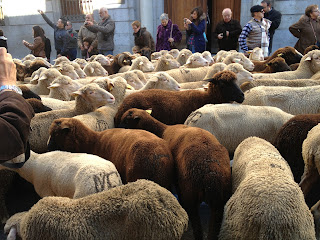Hola a todos, lamento que haya pasado tanto tiempo entre posts, pero me mudé y me llevó un tiempo conseguir mi internet de nuevo. Tengo algunos posts interesantes en los que estoy trabajando en la actualidad para la Fiesta de la trashumancia que ocurrieron a finales de octubre, por lo general el último domingo, aquí en Madrid. También tengo dos posts más acerca de lo que encontré en el museo Folk de Segovia, Casa del Sol, y lo que viene esta semana es la Campaña por la lana en España.
But while I get those posts organized I did not want to leave the blog empty. So here is the video footage that I took during the Fiesta de Trashumancia:
Pero mientras organizo esos posts no quería dejar el blog vacío. Así que aquí está el video que tomé durante la Fiesta de Trashumancia:
El vídeo y el desfile comienza con los cuernos de los pastores y con los perros que utilizan para las ovejas. A continuación podréis ver varios vestidos regionales, y cómo música y bailes de la gente de diferentes regiones están representadas en el desfile. Por supuesto, el significado de la Trashumancia es mover el ganado de un campo a otro, por lo que las ovejas no son el único animal representado. Hay un montón de bueyes, y, por supuesto, los caballos y los perros utilizados para ayudar a los pastores a mover sus ganados.
If you look carefully in the video you can see that a lot of wool garments are worn. Also the saddle blankets of the horses are woven of wool in the natural colors of brown and white. The exact colors of the merinos that passed. You will also notice the wooden shoes some of the shepherds are wearing, an ancient shoe design made to help walk on mud.
Si os fijáis bien en el video se puede ver que una gran cantidad de gente lleva prendas de lana. También las mantas de los caballos de silla son tejidos de lana en los colores naturales de marrón y blanco. Los colores exactos de los merinos que véis pasar. También os daréis cuenta de los zapatos de madera algunos de los pastores llevan puestos, un antiguo diseño de calzado hecho para ayudar a caminar por el barro.

I enjoyed that video. Then I watched another longer one, which was probably done by someone else. I liked the painted wagon, which was shown from the other side.
ResponderEliminarI've never seen shoes like those wooden ones! A parade like that is really a little slice of culture. Very interesting! Thanks for sharing.